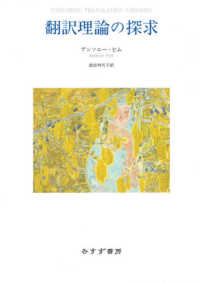- ホーム
- > 洋書
- > 英文書
- > History / World
Full Description
This third volume in the series is devoted to presenting and interpreting the metallurgical evidence from Ban Chiang, northeast Thailand, in the broader regional context. Because the production of metal artifacts must engage numerous communities in order to acquire and process the raw materials and then create and distribute products, understanding metals in past societies requires a regional perspective. This is the first book to compile, summarize, and synthesize the English-language copper production and exchange evidence available so far from Thailand and Laos in a thorough and systematic manner.
Chapters by Vincent C. Pigott and Thomas O. Pryce examine in detail the mining and smelting of copper in several sites, and the lead-isotope evidence for the sourcing of artifacts found in two of the consumption sites included in the study. Another chapter compiles the metal consumption evidence, including results of technical studies on prehistoric metals recovered from more than 35 sites excavated in central and northeast Thailand. This compilation demonstrates important regional variation in chaÎnes opÉratoires, allowing explication and synthesis of the technological traditions found in this region during prehistory. The review and compilation sheds new light on the social and economic context for the adoption and development of metallurgy in this part of the world. One key insight is that Thailand presents a case for a "community-driven bronze age," where the choices of peaceful local communities, not elites or centralized political entities, shaped how metal technological systems were implemented in this region.
This fresh perspective on the role of metallurgy in ancient societies contributes to an expanded global understanding of how humans have engaged metal technologies, contributing to debunking the conventional paradigm that emphasized a top-down view and a standardized metallurgical sequence, a paradigm that has dominated archeometallurgical studies for the last century or more.
Thai Archaeology Monograph Series, 2C
University Museum Monograph, 153
-

- 洋書
- Tiny Tin Elf
-

- 電子書籍
- 100万ドルの女 フラワーコミックス





